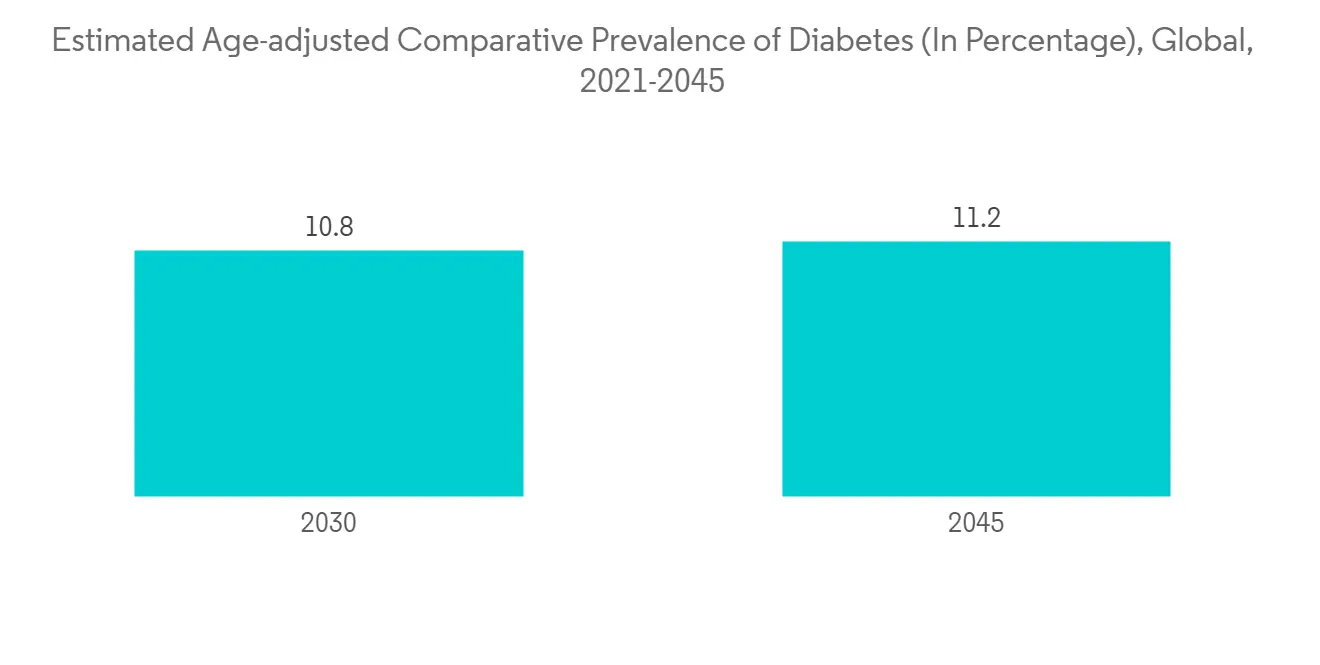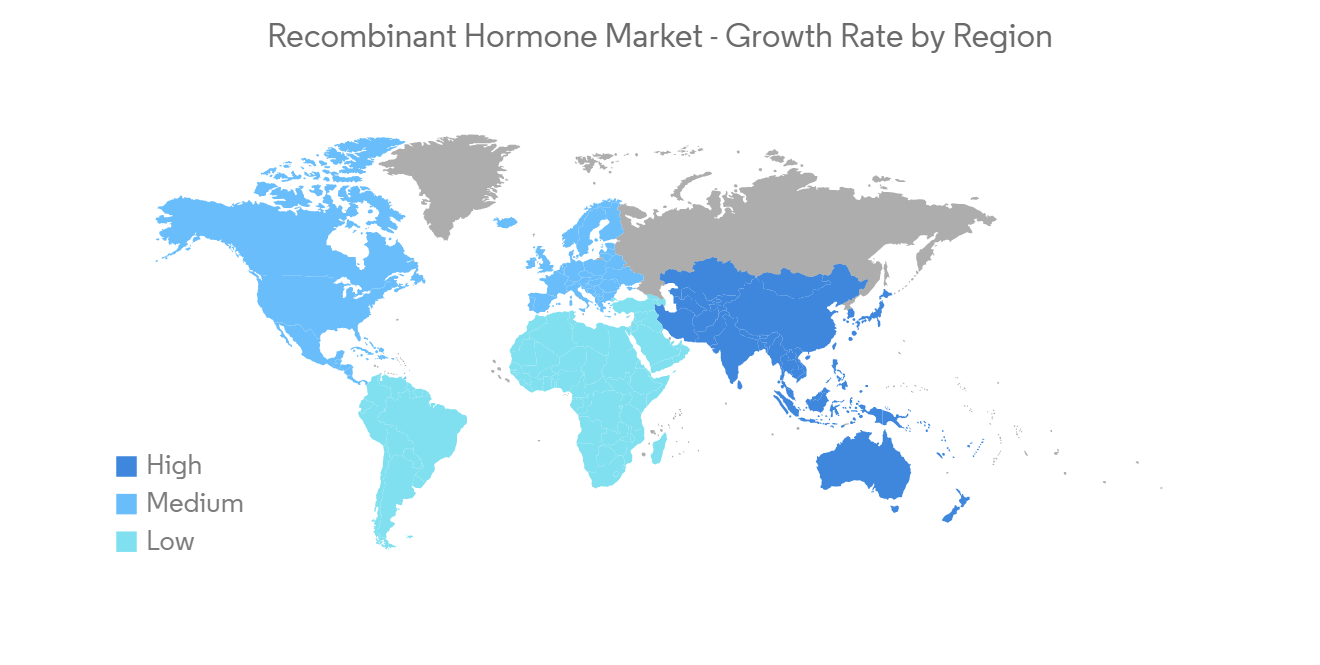 |
市場調査レポート
商品コード
1273448
組換えホルモン市場- 成長、動向、予測(2023年-2028年)Recombinant Hormone Market - Growth, Trends, and Forecasts (2023 - 2028) |
||||||
● お客様のご希望に応じて、既存データの加工や未掲載情報(例:国別セグメント)の追加などの対応が可能です。 詳細はお問い合わせください。
| 組換えホルモン市場- 成長、動向、予測(2023年-2028年) |
|
出版日: 2023年04月14日
発行: Mordor Intelligence
ページ情報: 英文 115 Pages
納期: 2~3営業日
|
- 全表示
- 概要
- 目次
組換えホルモン市場は、予測期間中に6.4%のCAGRで推移すると予想されています。
COVID-19が組換えホルモン市場の成長を促進すると予想されます。COVID-19発生時の糖尿病などの疾患リスクの高まりが、同市場におけるインスリンなどの組換えホルモンの需要を促進すると予測されます。例えば、2022年2月、マサチューセッツ総合病院は、世界中のCOVID-19入院患者において、新たに糖尿病と診断された割合が高い(NDDM)ことが記録されたと述べた。この新規糖尿病患者の高い割合が、組換えインスリンの必要性を高める。このように、COVID-19の発生は、パンデミック期間中の組換えホルモン市場の成長を促進すると予想されます。しかし、パンデミックには補助金が支給されているため、異なる疾患への組換えホルモンの適用により、市場は安定した成長を予測することが期待されます。
市場を牽引する主な要因としては、成長障害や糖尿病の増加または高負担、組換えホルモン療法の開発における技術的進歩が挙げられます。例えば、IDF Diabetes Atlas 2021によると、世界で糖尿病と共存している成人の数は5億3,700万人と推定されます。このように糖尿病の負担が大きいことから、組換えインスリンを用いた高度な治療の必要性が高まり、調査期間中、市場を牽引すると予想されます。
さらに、安全性を確認するための組換えホルモンに関する新たな調査により、製品の普及が進み、市場の成長を後押ししています。例えば、2022年7月にFrontiers in Endocrinologyが発表した研究報告書によると、PEG化組換えヒト成長ホルモン、Jintrolongは、カニクイザルおよびヒト小児成長ホルモン欠乏症患者において良好な長期安全性を示しています。本製品のより良い安全性プロファイルは、薬剤の使用量を増加させ、予測期間中に市場を推進することが期待されます。
したがって、糖尿病の高い負担や組換えホルモンに関する新しい調査などの要因が、組換えホルモンの使用量を増加させ、市場成長を後押しする可能性が高いと予想されます。しかし、組換えホルモン療法に伴う副作用や厳しい規制プロセスが、予測期間中の市場成長を阻害する要因となっています。
組換えホルモンの市場動向
予測期間中、インスリン分野が市場の主要シェアを占めると予想される
インスリンホルモンは、膵臓のランゲルハンス島のβ細胞から分泌され、血液中のブドウ糖を異化します。インスリンは、血糖値が高くなりすぎたり(高血糖)、低くなりすぎたり(低血糖)しないようにする働きがあります。糖尿病の症例が増加していることに加え、新たな市場開拓や製品の発売により、インスリンの使用量が増加しており、予測期間中に市場を押し上げると予想されます。
IDF Diabetes Atlas 2021によると、世界の糖尿病成人の総数は2030年に6億4,300万人と推定され、2045年には7億8,400万人に増加すると予想されています。したがって、糖尿病の負担増は、予測期間中に市場を牽引するリコンビナントインスリンの使用量に大きな影響を及ぼすと予想されます。
さらに、市場セグメントにおける新製品の開発および発売は、市場の成長を後押しすると予想されます。例えば、2021年11月、Viatris Inc.とBiocon Biologics Ltd.は、1型糖尿病の成人および小児患者、2型糖尿病の成人の高血糖をコントロールするために、組み換えヒト長時間作用型インスリンアナログである互換バイオシミラーSEMGLEE(インスリングラルギン-yfgn)を米国で発売しました。したがって、新製品の発売は、ホルモン性疾患の高い負担とともに、市場プレイヤーの製品ポートフォリオを拡大するのに役立ち、予測期間中の市場成長を促進すると予想されます。
このように、糖尿病の負担増と新製品の発売により、市場のインスリンセグメントは予測期間中にかなりの成長を遂げると予想されます。

北米は予測期間中、市場で大きなシェアを占めると予想されます。
北米は、研究への支出の増加やホルモン疾患の発生率の増加により、組換えホルモン市場で大きなシェアを占めると予想されます。上記の要因に加えて、この地域には高度なヘルスケアインフラと複数の大手市場関係者が存在するため、予測期間中に市場が大きく成長することが期待されます。
NIH RCDC 2022によると、米国における糖尿病の研究資金は2021年に11億2,400万米ドルと推定され、2023年には12億900万米ドルに上昇すると予測されています。この研究資金は様々なカテゴリーに分かれており、組換えホルモンのような先進的な治療研究も含まれており、予測期間中に市場を押し上げると予想されています。さらに、同地域における新製品の開発・発売は、同地域における用途の拡大を増加させます。
例えば、2021年10月、Ascendis Pharma A/Sは、体重11.5kg以上で内因性成長ホルモン(GH)の分泌不全による成長不全を有する1歳以上の小児患者を対象とした週1回投与の治療薬「SKYTROFA(lonapegsomatropin-tcgd)」を米国で発売しました。同様に、2021年10月、ファイザー・カナダULCは、次世代型長時間作用型成長ホルモン注射剤「PrNGENLA」(ソマトログン)の承認をカナダ保健省から取得しました。NGENLAは、内因性成長ホルモンの分泌不足による成長不全(成長ホルモン分泌不全症、GHD)の小児患者を長期治療するための週1回投与の長時間作用型遺伝子組換えヒト成長ホルモンです。このように、同地域では新製品の発売が普及を後押ししており、予測期間中に市場を押し上げると予想されます。
したがって、ホルモン疾患の高い有病率や、製品の承認や発売などの最新の企業活動など、前述のすべての要因は、組換えホルモン製品の使用量を増加させ、予測期間中に市場の成長を促進する可能性が高いと予想されます。

組換えホルモンの産業概要
組換えホルモン市場は、少数の大手企業によって構成され、統合されています。市場シェアでは、現在、数社の大手企業が市場を独占しています。今後数年間は、技術共有のための共同研究や合併が行われ、この分野での技術革新のための投資が増加すると予想されます。主な市場参入企業には、Eli Lilly and Company、Ferring Pharmaceuticals、Hoffmann La Roche Ltd(Genentech, Inc)、Merck &Co Inc、Pfizer Inc、Novo Nordisk A/S, Novartis AG、Ipsen Pharma、LG Life SciencesおよびTeva Pharmaceutical Industriesがあります。
その他の特典:
- エクセル形式の市場予測(ME)シート
- 3ヶ月間のアナリストサポート
目次
第1章 イントロダクション
- 調査の前提条件と市場定義
- 本調査の対象範囲
第2章 調査手法
第3章 エグゼクティブサマリー
第4章 市場力学
- 市場概要
- 市場促進要因
- 成長障害と糖尿病の発生率の増加
- 組換えホルモン療法の開発における技術的進歩
- 市場抑制要因
- 組換えホルモン療法に関連する副作用
- 厳しい規制プロセス
- ポーターのファイブフォース分析
- 新規参入業者の脅威
- 買い手/消費者の交渉力
- 供給企業の交渉力
- 代替品の脅威
- 競争企業間の敵対関係
第5章 市場セグメンテーション
- 製品タイプ別
- 成長ホルモン
- インスリン
- 卵胞刺激ホルモン
- その他の製品
- 地域別
- 北米
- 米国
- カナダ
- メキシコ
- 欧州
- ドイツ
- 英国
- フランス
- イタリア
- スペイン
- その他欧州
- アジア太平洋地域
- 中国
- 日本
- インド
- オーストラリア
- 韓国
- その他アジア太平洋地域
- 中東・アフリカ地域
- GCC
- 南アフリカ
- その他中東とアフリカ
- 南米
- ブラジル
- アルゼンチン
- その他南米地域
- 北米
第6章 競合情勢
- 企業プロファイル
- Eli Lilly and Company
- Ferring Pharmaceuticals
- F. Hoffmann-La Roche Ltd(Genentech, Inc)
- Merck & Co Inc
- Pfizer Inc
- Novo Nordisk A/S
- Novartis AG
- Ipsen Pharma
- LG Life Sciences
- Teva Pharmaceutical Industries
- Bio-Rad Laboratories, Inc
- Biocon
第7章 市場機会および将来動向
The recombinant hormone market is expected to register a CAGR of 6.4% over the forecast period.
COVID-19 is expected to drive the growth of the recombinant hormone market. The increased risk for diseases like diabetes during the COVID-19 outbreak is expected to drive the demand for recombinant hormones like insulin in the market. For instance, in February 2022, Massachusetts General Hospital stated that, in COVID-19 hospital admissions worldwide, high rates of newly diagnosed Diabetic Mellitus (NDDM) had been recorded. This high rate of new diabetes cases increases the need for recombinant insulin. Thus, the outbreak of COVID-19 is expected to drive the growth of the recombinant hormone market during the pandemic period. However, as the pandemic has been subsidized, the market is expected to project stable growth due to the application of recombinant hormones in different diseases.
The major factors that drive the market include the increasing or high burden of growth disorders and diabetes and technological advancements in the development of recombinant hormonal therapies. For instance, as per the IDF Diabetes Atlas 2021, the number of adults that are living with diabetes worldwide is estimated to be 537 million. This high burden of diabetes increases the need for advanced treatment using recombinant insulin and is expected to drive the market over the study period.
Furthermore, the new research studies on the recombinant hormones for accessing the safety profile increase the widespread of the products that help boost the market's growth. For instance, as per the study report published by Frontiers in Endocrinology in July 2022, PEGylated recombinant human growth hormone, Jintrolong, exhibited good long-term safety in cynomolgus monkeys and human pediatric growth hormone deficiency patients. The better safety profile of the product increases the usage of the drug and is expected to propel the market over the forecast period.
Hence, the factors like the high burden of diabetes and new research studies on recombinant hormones are expected to increase the usage of recombinant hormones and likely boost the market growth. However, adverse effects associated with recombinant hormonal therapies and stringent regulatory processes are the factors that hinder market growth over the forecast period.
Recombinant Hormone Market Trends
Insulin Segment is Expected to Hold a Major Share in the Market Over the Forecast Period
The insulin hormone is secreted by the beta cells of Islets of Langerhans of the pancreas, which catabolizes glucose in the blood. Insulin helps to keep blood sugar levels from getting too high (hyperglycemia) or too low (hypoglycemia). The increasing cases of diabetes, along with new developments and product launches, increase the usage of insulin, which is expected to boost the market over the forecast period.
According to the IDF Diabetes Atlas 2021, the total number of adults with diabetes worldwide is estimated to be 643 million in 2030, which is expected to rise to 784 million by 2045. Hence, the increasing burden of diabetes is expected to have a significant impact on the recombinant insulin usage that drives the market over the forecast period.
Furthermore, new product developments and launches in the market segment are expected to boost the market's growth. For instance, in November 2021, Viatris Inc. and Biocon Biologics Ltd. launched the interchangeable biosimilars SEMGLEE (insulin glargine-yfgn), a recombinant human long-acting insulin analog, in the United States to help control high blood sugar in adult and pediatric patients with type 1 diabetes and adults with type 2 diabetes. Hence, the new product launches, along with the high burden of hormonal diseases, help to expand the product portfolio of the market players, which is expected to propel the market growth over the forecast period.
Thus, owing to the rising burden of diabetes and the launch of new products, the insulin segment of the market is expected to have considerable growth over the forecast period.

North America is Expected to Hold a Significant Share in the Market Over the Forecast Period.
North America is expected to hold a major market share in the recombinant hormone market owing to the increasing expenditure on research and increasing incidence of hormonal disorders. In addition to the above-mentioned factors, the presence of advanced healthcare infrastructure and several major market players in the region is expected to have significant growth in the market over the forecast period.
According to the NIH RCDC 2022, the funding for the research on diabetes in the United States is estimated to be USD 1,124 million in 2021, which is expected to rise to USD 1,209 million by 2023. This research funding involves various categories, which also involve advanced treatment studies like recombinant hormones, and is expected to boost the market over the forecast period. Furthermore, new product developments and launches in the region increase the expansion of applications in the region.
For instance, in October 2021, Ascendis Pharma A/S launched SKYTROFA (lonapegsomatropin-tcgd), its once-weekly treatment for the treatment of pediatric patients one year and older who weigh at least 11.5 kg (25.4 lb) and have growth failure due to inadequate secretion of endogenous growth hormone (GH) in the United States. Similarly, in October 2021, Pfizer Canada ULC received approval for its next-generation long-acting growth hormone injection, PrNGENLA (somatrogon), from Health Canada. NGENLA is a once-weekly long-acting recombinant human growth hormone for the long-term treatment of pediatric patients who have growth failure due to an inadequate secretion of endogenous growth hormone (growth hormone deficiency or GHD). Thus, the new product launches in the region help increase the widespread applications, which are expected to boost the market over the forecast period.
Therefore, all the aforementioned factors, like the high prevalence of hormonal diseases and the latest company activities like product approvals and launches, are expected to increase the usage of recombinant hormone products and likely propel the market to grow over the forecast period.

Recombinant Hormone Industry Overview
The recombinant hormone market is consolidated and consists of a few major players. In terms of market share, a few of the major players are currently dominating the market. Collaborations and mergers over the next coming years to share technology and increasing investments for innovation in the field are expected to be observed. Some of the major market players include Eli Lilly and Company, Ferring Pharmaceuticals, Hoffmann La Roche Ltd (Genentech, Inc), Merck & Co Inc, Pfizer Inc, Novo Nordisk A/S, Novartis AG, Ipsen Pharma, LG Life Sciences and Teva Pharmaceutical Industries.
Additional Benefits:
- The market estimate (ME) sheet in Excel format
- 3 months of analyst support
TABLE OF CONTENTS
1 INTRODUCTION
- 1.1 Study Assumptions and Market Definition
- 1.2 Scope of the Study
2 RESEARCH METHODOLOGY
3 EXECUTIVE SUMMARY
4 MARKET DYNAMICS
- 4.1 Market Overview
- 4.2 Market Drivers
- 4.2.1 Increasing Incidence of Growth Disorders and Diabetes
- 4.2.2 Technological Advancements in Development of Recombinant Hormonal Therapies
- 4.3 Market Restraints
- 4.3.1 Adverse Effects Associated with Recombinant Hormonal Therapies
- 4.3.2 Stringent Regulatory Processes
- 4.4 Porter's Five Forces Analysis
- 4.4.1 Threat of New Entrants
- 4.4.2 Bargaining Power of Buyers/Consumers
- 4.4.3 Bargaining Power of Suppliers
- 4.4.4 Threat of Substitute Products
- 4.4.5 Intensity of Competitive Rivalry
5 MARKET SEGMENTATION (Market Size by Value - USD million)
- 5.1 By Product Type
- 5.1.1 Growth Hormone
- 5.1.2 Insulin
- 5.1.3 Follicle-stimulating Hormone
- 5.1.4 Other Products
- 5.2 Geography
- 5.2.1 North America
- 5.2.1.1 United States
- 5.2.1.2 Canada
- 5.2.1.3 Mexico
- 5.2.2 Europe
- 5.2.2.1 Germany
- 5.2.2.2 United Kingdom
- 5.2.2.3 France
- 5.2.2.4 Italy
- 5.2.2.5 Spain
- 5.2.2.6 Rest of Europe
- 5.2.3 Asia-Pacific
- 5.2.3.1 China
- 5.2.3.2 Japan
- 5.2.3.3 India
- 5.2.3.4 Australia
- 5.2.3.5 South Korea
- 5.2.3.6 Rest of Asia-Pacific
- 5.2.4 Middle East and Africa
- 5.2.4.1 GCC
- 5.2.4.2 South Africa
- 5.2.4.3 Rest of Middle East and Africa
- 5.2.5 South America
- 5.2.5.1 Brazil
- 5.2.5.2 Argentina
- 5.2.5.3 Rest of South America
- 5.2.1 North America
6 COMPETITIVE LANDSCAPE
- 6.1 Company Profiles
- 6.1.1 Eli Lilly and Company
- 6.1.2 Ferring Pharmaceuticals
- 6.1.3 F. Hoffmann-La Roche Ltd (Genentech, Inc)
- 6.1.4 Merck & Co Inc
- 6.1.5 Pfizer Inc
- 6.1.6 Novo Nordisk A/S
- 6.1.7 Novartis AG
- 6.1.8 Ipsen Pharma
- 6.1.9 LG Life Sciences
- 6.1.10 Teva Pharmaceutical Industries
- 6.1.11 Bio-Rad Laboratories, Inc
- 6.1.12 Biocon
